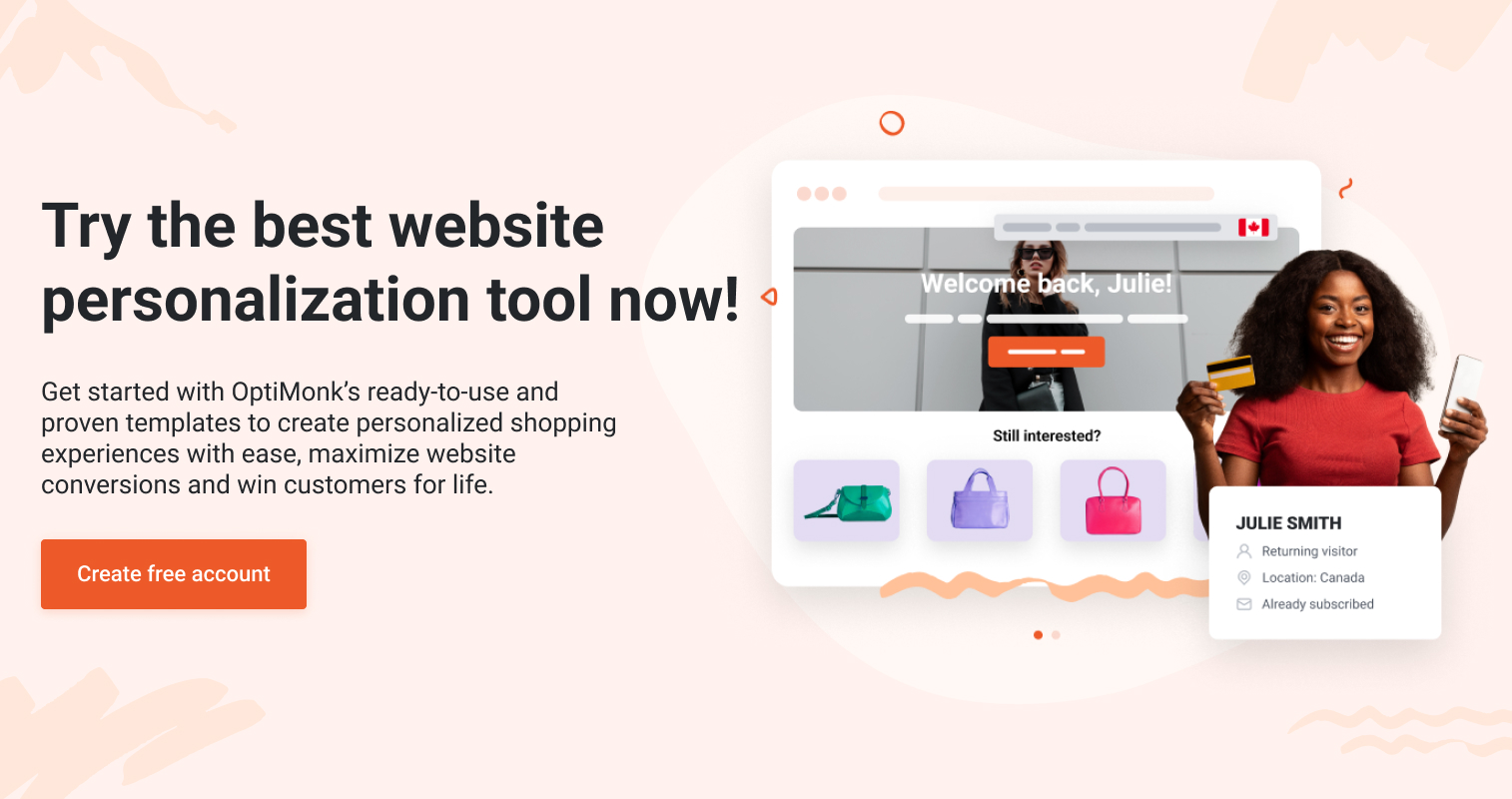Have you ever shopped online and saw an irrelevant offer?
Maybe you were shopping for a swimsuit but the website you were browsing kept offering you discounts on coats and jackets. It’s frustrating when your user experience has nothing to do with what you’re actually interested in!
That’s why web personalization is an increasingly important part of modern ecommerce.
Today, online stores can deliver relevant content based on individual consumer data across the entire customer journey, which makes the shopping experience much easier and more enjoyable. Stores accomplish this by using all the available data on their customers to understand what they’re interested in, which enables them to provide highly personalized experiences.
It might seem complicated to provide customized content on your website, but there are actually lots of easy ways to deliver a personalized customer experience for your visitors.
In this article, we’ll go over the basics of personalized content and cover 5 awesome website personalization examples. Finally, we’ll go over how you can use the same personalization strategies as top ecommerce brands on your own website.
Ready to learn about personalization? Let’s get started!
What is personalized content?
Personalized content (also known as dynamic content) basically means delivering content to your visitors and customers based on their previous interactions with your site, plus demographic data, contextual data, and behavioral data.
Essentially, content personalization requires you to utilize all the data and information available about your visitors to create unique experiences for them.
Personalized content comes in many forms. You can display personalized content on a website (including headlines, CTAs, overlay messages, etc.), but content personalization can also be used in emails, retargeting ads, and more.
Why is it important to deliver a personalized experience?
Dozens of studies show that consumers have come to expect personalization on a website. Visitors will get annoyed if they have to take more time than necessary to find what they’re looking for or complete their purchase.
Let’s take a look at some of the statistics:
- 91% of consumers say they’re more likely to shop with businesses that provide relevant offers and recommendations.
- 74% of customers are frustrated when website content isn’t personalized.
- 88% of marketers saw measurable improvements thanks to personalization.
Common customer data points available for website personalization
As mentioned, you can personalize content based on three broad types of data: demographic data, contextual data, and behavioral data. Let’s discuss these data types in more detail!
Demographic data includes definite data points, like:
- Location
- Age
- Education level
- Marital status
Contextual data supplies additional context about how a visitor is browsing your site. Some examples are:
- Device type
- Which browser they’re using
Behavioral data (or site behavior) provides insights into what users do when they’re on your site, like:
- Visited URLs
- Time spent on site
- Traffic source
- Awareness stage
- Past purchases
Each of these pieces of customer data can be used to split your overall target audience into different segments with something in common.
For example, you could send certain messages to site visitors who are at an early awareness stage, and different messages to those who are far enough along to have formed purchase intent.
Good website personalization is all about finding segments of visitors who share characteristics and specific interests. If you can do that, you’ll be able to create content (whether for marketing campaigns, content marketing, or email marketing) that’s tailored to the interests of those specific groups of customers.
5 content personalization examples for ecommerce
Now that we’ve gone over the basics of website personalization, it’s time to take a look at 5 examples of how successful ecommerce businesses have used personalization to improve their customers’ online experience.
1. Care/of
Care/of is an ecommerce website that sells subscription vitamin and supplement plans.
To set their site apart, they use one of the most powerful tools for gathering relevant information about audience segments: a quiz that helps their customers understand which products are right for them.
The main call to action on the Care/of site is “Take the quiz,” as you can see from the landing page below:
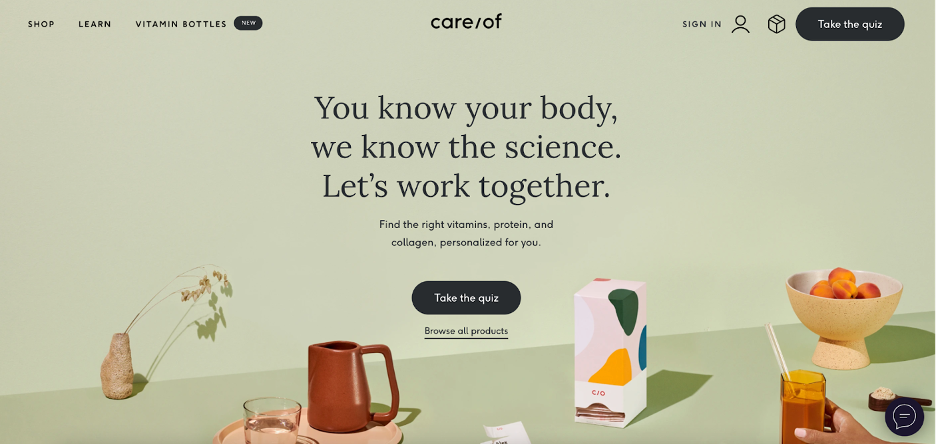
After a site visitor takes the quiz, they get recommendations about the best vitamin regimen for them. Even if an individual doesn’t make a purchase, Care/of has still collected plenty of valuable information that will help them run personalized remarketing campaigns.
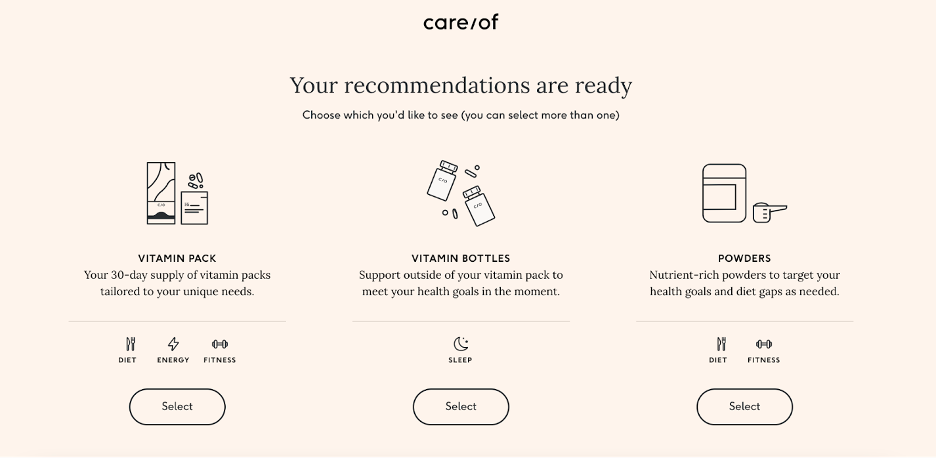
Importantly for a health-focused business, Care/of uses lots of information to back up the recommendations they make.
Notice how all the content presented looks clear and professional. This is a reminder that even if you offer personalized content, it still needs to be winning content that customers can trust.
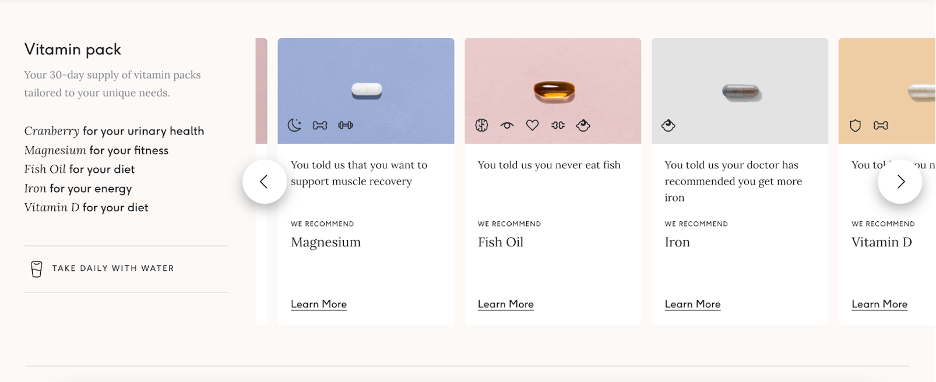
Recommended reading: The Secret Behind the Care/of Marketing Strategy: How They Became a 225 Million-Dollar Brand
2. Lunya
Lunya is a sleepwear and lingerie ecommerce site that uses several different personalization tactics.
First off, they really focus on getting users to sign up for an account on their website. This is a great way to promote customer loyalty, but also to gather lots of customer data over a long period of time. And because they know a lot about their users’ interests, it’s easy to provide relevant, targeted content.
They kick off the personalized experience by greeting their customers by name.

Lunya also personalizes their website with dynamic content to show country-specific information to their visitors.
In the popup below, they don’t just inform visitors from Hungary that they ship to their country… they also tell them how much they need to spend to qualify for free shipping. As a nice touch, they give this information in the local currency as well.
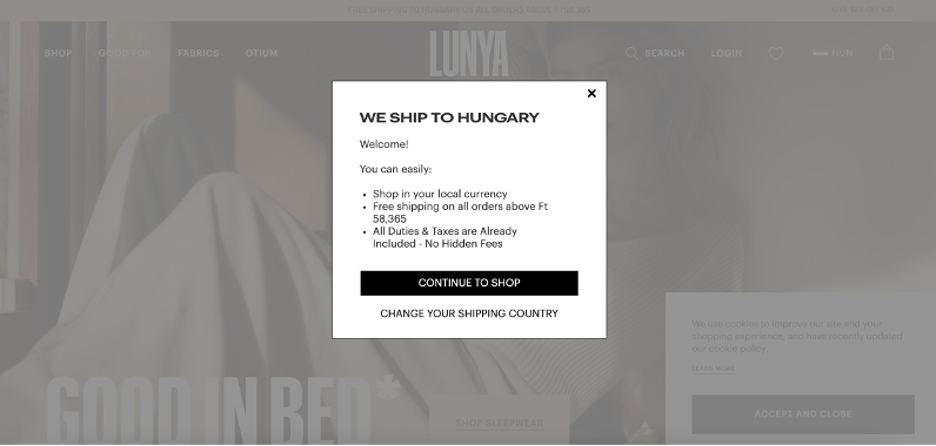
Recommended reading: Marketing Breakdown: How Lunya Achieved $25M Revenue
3. Dollar Shave Club
Dollar Shave Club, which is a company that sells subscription-based bundles of personal care products, also uses a quiz to collect data about their customers.
Their quiz feels like a conversation, and asks their users about their typical routine for getting ready in the morning.

Here’s one of the questions on the quiz:
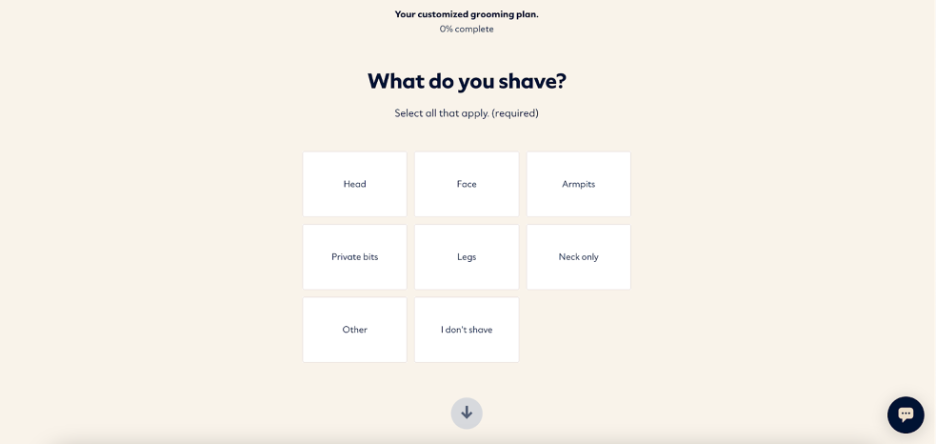
After completing the quiz, visitors get personalized recommendations:

Recommended reading: Dollar Shave Club Marketing Success: From Viral Video to Billion-Dollar Company
4. ASOS
ASOS is a clothing brand headquartered in the U.K. They sell both their own line of products and items by other designers.
On the screen below, you’ll see two different web personalization tactics.
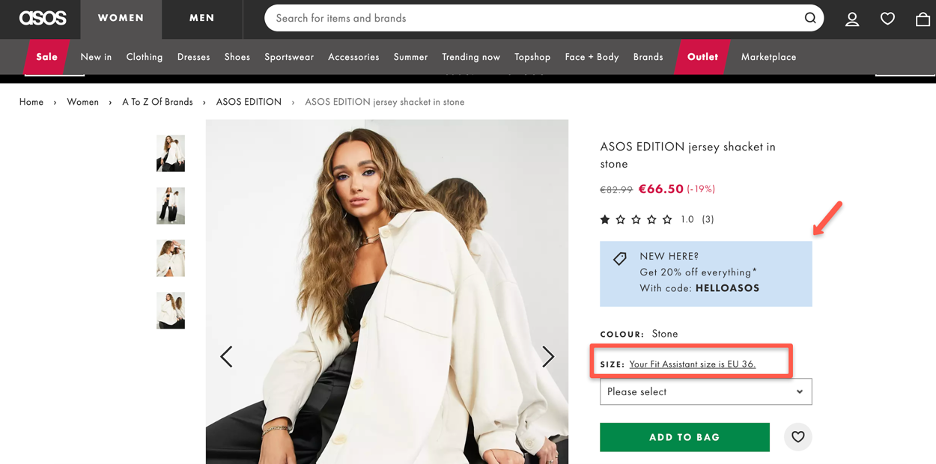
First, they have dynamic content on product pages offering a 20% discount for new visitors only.
Second, they have a sizing system on their website that not only remembers your size but also converts it automatically to standard sizes from around the world. This is a great example of personalizing small aspects of the customer experience to make shopping easier and more convenient—which is something your customers will really appreciate.
5. Urban Outfitters
Urban Outfitters is a famous clothing brand with tons of loyal customers. That means they have lots of data about their customers’ past purchases.
Based on each specific customer’s buying history, Urban Outfitters suggests new products they might like.
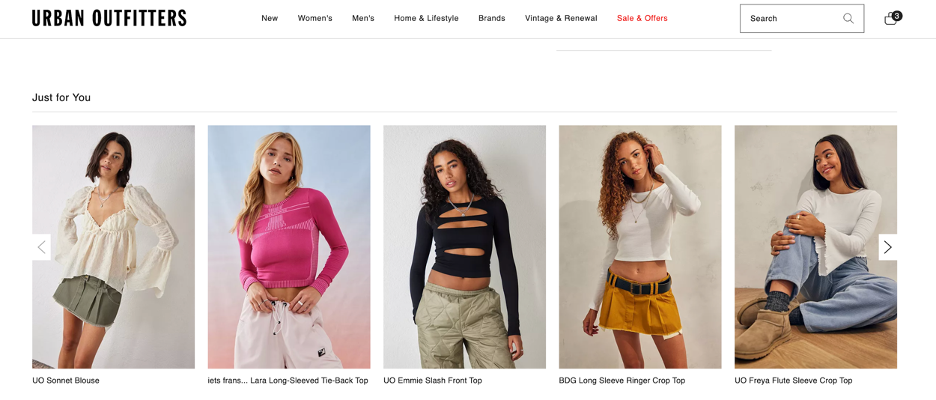
Recommended reading: 13 Website Personalization Examples That Are Guaranteed to Boost Your Results
How to deliver personalized content?
The process of personalizing content can be summed up in 3 main steps:
Step 1: Audience discovery
The first step to website personalization is all about finding the right audiences to target with your personalized content.
This is where you should take a look at all the data you have available. Be sure to check out your Google Analytics account, which has several reports that can help you understand the problems visitors face while browsing your website. You want to smooth over any difficult parts of the customer journey to make it as easy and enjoyable as possible.
You should look for visitor segments that have significantly lower conversion rates compared to other segments. These low-performing visitor groups could be segmented by source, country, content, or landing pages visited (just to name a few).
For more information on audience discovery, check out this 4-min video:
Step 2: Message creation
Once you’ve decided which segments need more attention, it’s time to create messages for each of the visitor segments you’ve identified.
What kind of messages should you create? Well, it depends on both the segment you’re trying to target and the nature of your business. There’s no one-size-fits-all answer.
But in general, you want to get into your customers’ heads and think about how you can make the customer journey easier for them.
This video will help you find the right value proposition for each visitor segment:
Step 3: Evaluation
The final step is measuring and analyzing your results. You want to ensure that whichever software you’re using to personalize your website is providing a good return on investment.
A personalization tool like OptiMonk can make it easy to segment your audience, create personalized messages, and test them. Even if it turns out that your very first attempt at creating a personalized message is a success, you’ll still want to use A/B testing to further optimize your messaging.
At this point, you can circle back to step 1 and find more customer segments to focus on (and whose experience could be improved with personalization). Slowly, you’ll be able to use more and more of your marketing spend on high-converting personalized campaigns that get real results!
Recommended reading: The Ultimate Guide to Website Personalization
Final thoughts
The core of personalization in ecommerce is splitting your audience into groups that have common needs and interests. Once you’ve done that, you can show different versions of your content to each, enriching the user experience in a meaningful way.
If you’d like to try out some of the personalization strategies in this article, OptiMonk’s personalization software is a great way to get started. You can use pre-made templates to run quizzes like Care/of and Dollar Shave Club, or follow in Urban Outfitters’ footsteps with the Dynamic Product Recommendations feature.
Creating a personalized website has never been easier—why not start today?

